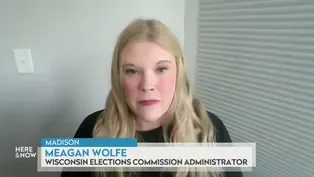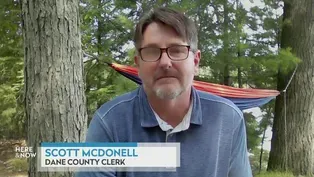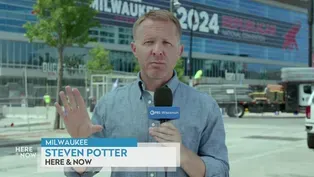Here and Now
Christy Remucal on Finding PFAS Contamination in Water Foams
Clip: Season 2300 Episode 2302 | 4m 19sVideo has Closed Captions
Christy Remucal on research of high concentrations of PFAS chemicals in river, lake foams.
UW-Madison civil and environmental engineering professor Christy Remucal explains implications of research revealing high concentrations of PFAS chemicals in naturally occurring river and lake foams.
Problems with Closed Captions? Closed Captioning Feedback
Problems with Closed Captions? Closed Captioning Feedback
Here and Now is a local public television program presented by PBS Wisconsin
Here and Now
Christy Remucal on Finding PFAS Contamination in Water Foams
Clip: Season 2300 Episode 2302 | 4m 19sVideo has Closed Captions
UW-Madison civil and environmental engineering professor Christy Remucal explains implications of research revealing high concentrations of PFAS chemicals in naturally occurring river and lake foams.
Problems with Closed Captions? Closed Captioning Feedback
How to Watch Here and Now
Here and Now is available to stream on pbs.org and the free PBS App, available on iPhone, Apple TV, Android TV, Android smartphones, Amazon Fire TV, Amazon Fire Tablet, Roku, Samsung Smart TV, and Vizio.
Providing Support for PBS.org
Learn Moreabout PBS online sponsorship>> Meagan Wolfe, thanks very much.
Thank you.
You know, the foam you sometimes see on the shores of lakes and rivers.
Be forewarned.
A new study shows the foam can contain very high levels of forever chemicals or PFAS, even if the water below may not.
The University of Wisconsin Aquatic Sciences Center analyzed foams and water of 43 lakes and rivers in Wisconsin.
Its director, Christy Remucal, is here with more on this finding.
And thanks a lot for being here.
>> Thanks for having me.
>> Really important information.
What does this foam look like?
>> So this looks like soap that you might see in a bathtub.
It's a white foamy material.
Sometimes you see it on a lake or a river, like on a windy day or downstream of a dam, places like that.
you found?
>> So we measured PFAS concentrations in this foam and also in water.
And what we found were the PFAS concentrations were 50 to 7000 times higher in the foam compared to in the water.
you find these highest readings?
>> The place where we found the highest concentrations were in Lake Monona here in Madison, Hayum so how dangerous is it to ingest?
So PFAS, the main way we're exposed to it is through ingestion.
So we mainly think about exposure through drinking water or food or things like that.
So the concentrations we're concerned about are very low.
The ones that can cause adverse health outcomes.
People probably aren't eating a lot of foam, but we still think it's good to avoid coming in contact with it.
would you give to folks who see it on on bodies of water?
>> I think our research really echoes what our state Department of Natural Resources has already said, that people should avoid coming into contact with foams.
They should keep their pets, their dogs out.
You know, they'll get into the foam.
They shouldn't have their kids play in the foam.
And if you do come into contact with it, you should wash your hands before eating or drinking.
high levels of PFAS in the foams didn't necessarily translate, though, to the water below.
>> Well, the ratios were relatively similar.
So if we if there was a lake that had higher concentrations of PFAS, we also had higher concentrations of PFAS in the foam.
So Lake Monona, for example, it had among the higher concentrations in water in the state as well as in the foam.
So they were correlated.
But I think the thing that was really surprising was because the concentration effect was so high in the foam, even a lake like Lake Mendota, which has lower concentrations in the water, you still found amounts in the foam that might be of concern.
>> So 43, site samples for this research, could we extrapolate and say, if you see this foam across the state, it's likely the same?
>> I think that's probably true.
We really try in this study to sample different water bodies.
Some lakes we know have higher concentrations of PFAS.
We also made sure to sample places where the concentrations are lower.
So we could look at how things varied depending on the site.
>> So how does this discovery help scientists understand how these forever chemicals move in groundwater?
And what is the implication of that.
which means they like to accumulate at the air, water interface.
So the very top of the water.
And so that's why they're in the foam where there's lots of little bubbles underground.
This partitioning behavior is really important for how PFAS move.
So in the subsurface there's little lots of these little interfaces.
So PFAS can kind of get trapped there.
And that slows down how they move.
And this process is really well known underneath the ground.
But this was one of the first times we saw it in lakes and rivers.
>> How does this research inform paths to PFAS cleanup?
>> Yeah.
So people are actually trying to generate foam on purpose as a way to concentrate PFAS and remove it from the water.
So that's something that's under research development right now.
So taking advantage of this natural ability of PFAS to accumulate in these types of environments, they're trying to use that as a remediation approach.
the scientific community to this, >> I think that's a good question.
And I mean, the paper just came out, so it's a little hard to know.
I think the thing that will probably be the most surprising is the concentrations of PFAS we found in foams in lakes and rivers that had lower concentrations in the water.
I concentrations in the water.
I
Here & Now opening for July 12, 2024
Video has Closed Captions
The introduction to the July 12, 2024 episode of Here & Now. (58s)
McCoshen & Ross on Expectations of the 2024 RNC in Milwaukee
Video has Closed Captions
Bill McCoshen, Scot Ross on the 2024 race for president as the RNC in Milwaukee starts. (8m 40s)
Meagan Wolfe on Absentee Ballot Drop Box Guidance for 2024
Video has Closed Captions
Meagan Wolfe on guidance for election clerks on unstaffed absentee ballot drop boxes. (8m 1s)
Public Safety and the 2024 Republican National Convention
Video has Closed Captions
Federal, state and local law enforcement agencies plan to secure 2024 RNC in Milwaukee. (2m 48s)
Scott McDonell on Using Absentee Ballot Drop Boxes in 2024
Video has Closed Captions
Scott McDonell on planning to deploy absentee ballot drop boxes in the Madison metro area. (4m 17s)
Steven Potter on Security Planning in Milwaukee For the RNC
Video has Closed Captions
Steven Potter on advance security planning by law enforcement agencies for the 2024 RNC. (2m 23s)
Providing Support for PBS.org
Learn Moreabout PBS online sponsorshipSupport for PBS provided by:
Here and Now is a local public television program presented by PBS Wisconsin

















